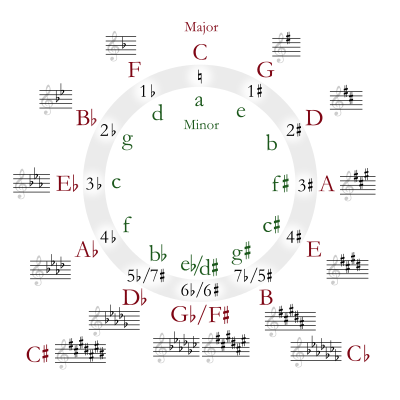C-sharp major
 | |
| Relative key |
A♯ minor enharmonic: B♭ minor |
|---|---|
| Parallel key | C♯ minor |
| Dominant key |
G♯ major enharmonic: A♭ major |
| Subdominant | F♯ major |
| Enharmonic | D♭ major |
| Component pitches | |
| C♯, D♯, E♯, F♯, G♯, A♯, B♯, C♯ | |
C♯ major (or C-sharp major) is a major scale based on C♯, consisting of the pitches C♯, D♯, E♯, F♯, G♯, A♯, and B♯. Its key signature has seven sharps.
Its relative minor is A♯ minor (or enharmonically B♭ minor) and its parallel minor is C♯ minor.
The direct enharmonic equivalent equivalent of C♯ major is D♭ major.
A harp tuned to C-sharp major has all its pedals in the bottom position. Because all the strings are then pinched and shortened, this is the least resonant key for the instrument.
Although most composers prefer to use the enharmonic equivalent D-flat major, since it only contains five flats as opposed to C-sharp major's seven sharps, Johann Sebastian Bach chose C-sharp major for Prelude and Fugue No. 3 in both books of the Well-Tempered Clavier. In Hungarian Rhapsody No. 6, Franz Liszt takes the unusual step of changing key from D-flat major to C-sharp major near the beginning of the piece. Maurice Ravel selected C-sharp major as the tonic key of Ondine from his piano suite Gaspard de la nuit. Erich Wolfgang Korngold composed his Piano Concerto for the Left Hand, Op. 17, in the key of C-sharp major.
In a few scores, 7-sharp key signatures in the bass clef are written with the sharp either for the A or for the A and the B on the top line.[1]
Louis Vierne used C-sharp major for the "Dona Nobis Pacem" of the Agnus Dei of his Messe Solennelle in C sharp minor.
References
External links
| Diatonic scales and keys | |||||||||||||||||||||||||||||||||||||||||||||||||||||||
|---|---|---|---|---|---|---|---|---|---|---|---|---|---|---|---|---|---|---|---|---|---|---|---|---|---|---|---|---|---|---|---|---|---|---|---|---|---|---|---|---|---|---|---|---|---|---|---|---|---|---|---|---|---|---|---|
 |
| ||||||||||||||||||||||||||||||||||||||||||||||||||||||
| The table indicates the number of sharps or flats in each scale. Minor scales are written in lower case. | |||||||||||||||||||||||||||||||||||||||||||||||||||||||